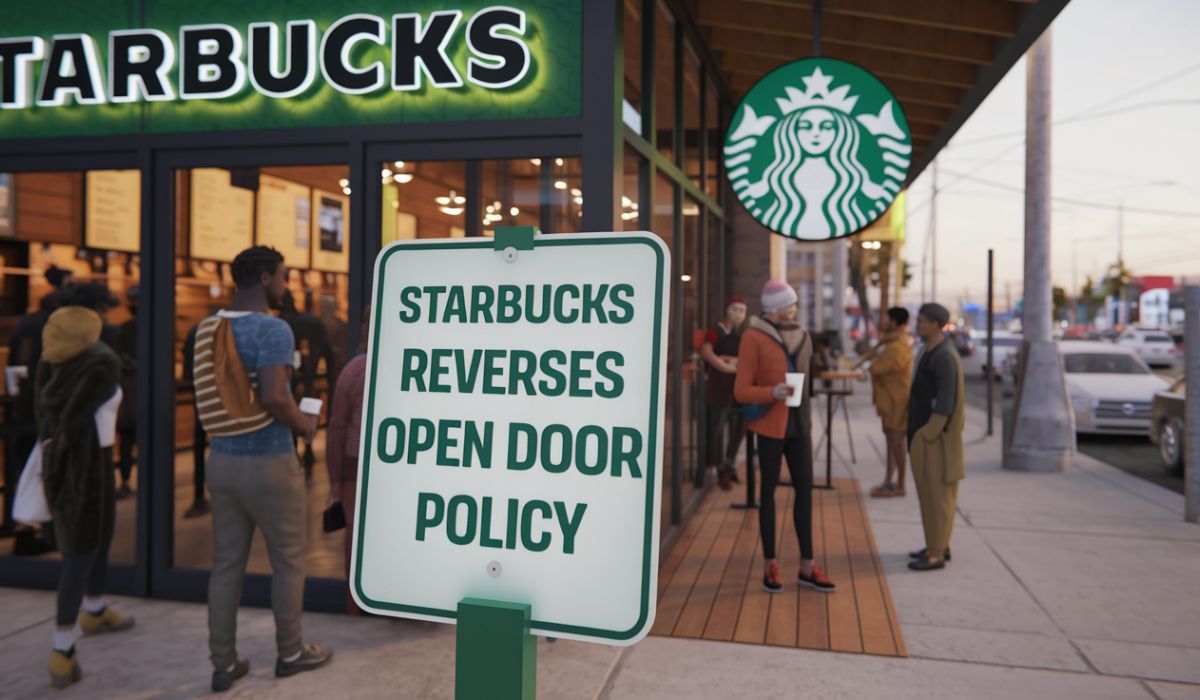Introduction
Have you ever walked into a Starbucks just to enjoy its cozy atmosphere without buying anything? For years, this was possible thanks to the company’s open-door policy. But in a surprising turn of events, Starbucks reverses open door policy, sparking widespread discussions. What does this mean for customers and communities? Let’s dive into the details and implications of this pivotal decision.
Why Starbucks Had an Open-Door Policy
Starbucks adopted the open-door policy in 2018, allowing anyone to use their spaces regardless of purchase. The idea was simple: create an inclusive and welcoming environment for all. The policy stemmed from the company’s mission of being a “third place” between home and work—a space where people could gather, connect, and relax.
But why did they make this bold decision? It was an effort to rebuild public trust after a controversial incident involving racial bias. By opening its doors, Starbucks sought to prove its commitment to community values. For many, it became a symbol of a progressive and customer-friendly approach.
The Reasons Behind the Policy Reversal
Fast forward to today, and Starbucks’ decision to reverse the policy has left many puzzled. The reasons boil down to operational challenges and safety concerns. The company cited increasing instances of disruptive behavior, which made it difficult for staff and paying customers to enjoy a comfortable experience.
Moreover, some store managers expressed frustration over having to deal with non-customers occupying prime seating or bathrooms for extended periods. These logistical hurdles ultimately outweighed the inclusivity benefits of the original policy.
How Customers Are Reacting
It’s no surprise that reactions to this decision have been mixed. Some customers feel the reversal is justified, noting that it prioritizes the paying patrons who keep Starbucks in business. Others argue that the move alienates vulnerable individuals who relied on Starbucks as a safe haven.
Social media platforms are buzzing with opinions. Tweets and posts often frame this as a clash between corporate interest and community responsibility. Regardless of your stance, one thing is clear: this decision has sparked a broader conversation about inclusivity versus practicality.
Impact on Starbucks Employees
Employees, often referred to as partners within Starbucks, are on the front lines of these changes. While some workers welcome the shift as it reduces pressure to manage non-paying guests, others worry about the ethical implications of turning people away.
“It’s a double-edged sword,” one barista noted. “On one hand, it’s easier to maintain a pleasant environment. On the other, it feels like we’re compromising on values.” The new policy also highlights the challenges of balancing employee well-being with corporate ethics.
Addressing Safety and Security Concerns
The primary driver behind this policy reversal is safety. Incidents of harassment, theft, and vandalism have reportedly increased, particularly in urban locations. By limiting the use of its spaces to paying customers, Starbucks aims to create a safer and more controlled environment.
Critics, however, question whether this approach effectively addresses the root causes of such behavior. Some suggest that investing in better security measures might have been a more equitable solution.
A Look at Starbucks’ Community Engagement Efforts
Despite this controversial decision, Starbucks remains committed to community engagement. Programs such as community service initiatives, charity partnerships, and scholarships demonstrate the company’s ongoing dedication to social impact.
These efforts suggest that while Starbucks may be scaling back its open-door policy, it isn’t abandoning its broader mission of supporting communities.
Comparing Policies with Competitors
Starbucks isn’t alone in grappling with such challenges. Companies like McDonald’s and Dunkin’ have faced similar dilemmas but often adopt stricter policies from the outset. Unlike Starbucks, many competitors prioritize clear boundaries to manage operational risks.
This shift aligns Starbucks more closely with industry norms but could dilute its unique appeal as a welcoming “third place.”
Economic Impacts of the New Policy
While the move aims to improve customer experience, it could have unforeseen economic implications. On the one hand, ensuring a pleasant atmosphere might attract more paying customers. On the other hand, it risks alienating individuals who value Starbucks’ community-centric approach.
The balance between maintaining profitability and staying true to brand values will likely determine the policy’s long-term success.
Customer Tips for Navigating the Change
For frequent visitors, adapting to this policy might seem daunting. Here are a few tips:
- Be Mindful: Ensure you make a purchase when utilizing Starbucks’ facilities.
- Timing Matters: Visit during less busy hours for a more relaxed experience.
- Seek Alternatives: Consider community centers or libraries for casual meetups.
These small adjustments can help customers make the most of their Starbucks visits.
Starbucks’ Official Statement and Vision
In its official statement, Starbucks emphasized that the policy change aligns with its vision to provide a safe and enjoyable environment for all patrons. “We remain committed to fostering an inclusive atmosphere while addressing operational realities,” the statement reads.
This balanced tone reflects the company’s effort to navigate a tricky situation without alienating its loyal customer base.
Expert Opinions on the Policy Shift
Experts in corporate ethics and business strategy have weighed in on the reversal. Some praise Starbucks for adapting to practical challenges, while others criticize it for sending mixed signals about its core values.
One analyst likened the situation to walking a tightrope: “Starbucks is trying to strike a balance between inclusivity and operational efficiency. It’s not an easy task.”
Lessons Other Businesses Can Learn
This case serves as a valuable learning opportunity for businesses worldwide. It highlights the importance of:
- Regularly Evaluating Policies: Ensuring they align with evolving challenges.
- Communicating Transparently: Keeping stakeholders informed about decisions.
- Balancing Values and Logistics: Striking the right chord between ethics and practicality.
These lessons can help other companies navigate similar challenges effectively.
Future Speculations for Starbucks
What does the future hold for Starbucks? Some speculate the company might introduce hybrid solutions, such as designated areas for non-paying guests. Others believe the focus will shift toward enhancing digital engagement to retain customers.
Only time will tell how this reversal shapes Starbucks’ trajectory.
How This Fits Into Broader Corporate Trends
The decision reflects a broader trend among corporations grappling with rising operational costs and public accountability. It underscores a growing tension between maintaining inclusivity and ensuring economic sustainability.
Other companies will likely monitor Starbucks closely to gauge customer and community reactions.
Conclusion and Final Thoughts
Starbucks’ decision to reverse its open-door policy marks a significant shift in its strategy. While the move addresses pressing safety and operational concerns, it also raises questions about inclusivity and corporate responsibility. As this change unfolds, one thing is certain: Starbucks will continue to evolve to meet the needs of its diverse audience.
FAQs
1. Why did Starbucks reverse its open-door policy? Starbucks cited increased safety concerns and operational challenges as the main reasons for the reversal.
2. How will this policy change affect non-paying visitors? Non-paying visitors may no longer have access to seating areas and bathrooms, as the spaces will now prioritize paying customers.
3. Does Starbucks still support community initiatives? Yes, Starbucks remains committed to community engagement through various programs and partnerships.
4. How have other companies addressed similar challenges? Competitors often maintain stricter policies from the outset to manage operational risks, focusing on clear boundaries for customer access.
5. What alternatives are available for non-paying individuals? Community centers, libraries, and other public spaces offer free alternatives for those seeking a welcoming environment.
For More Visit : usweekly.uk



